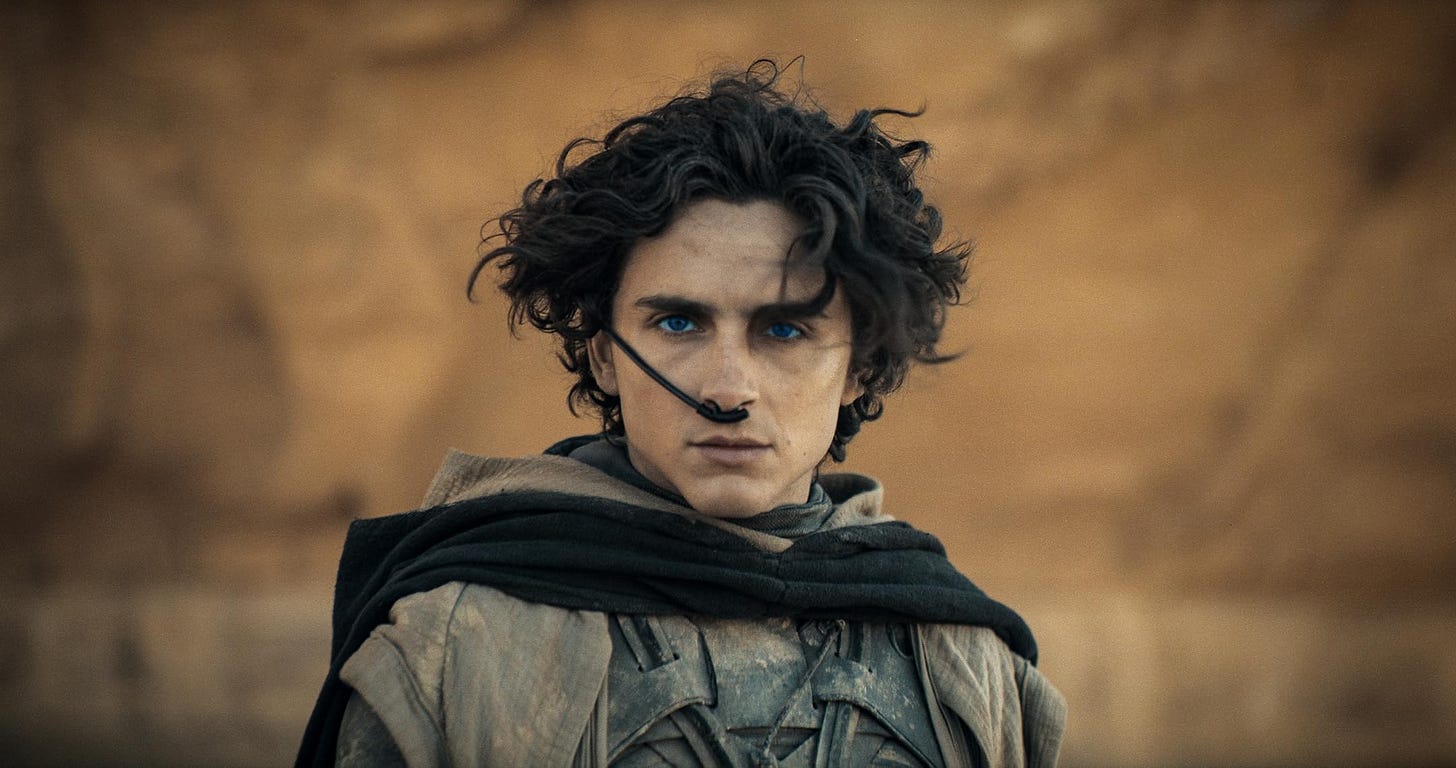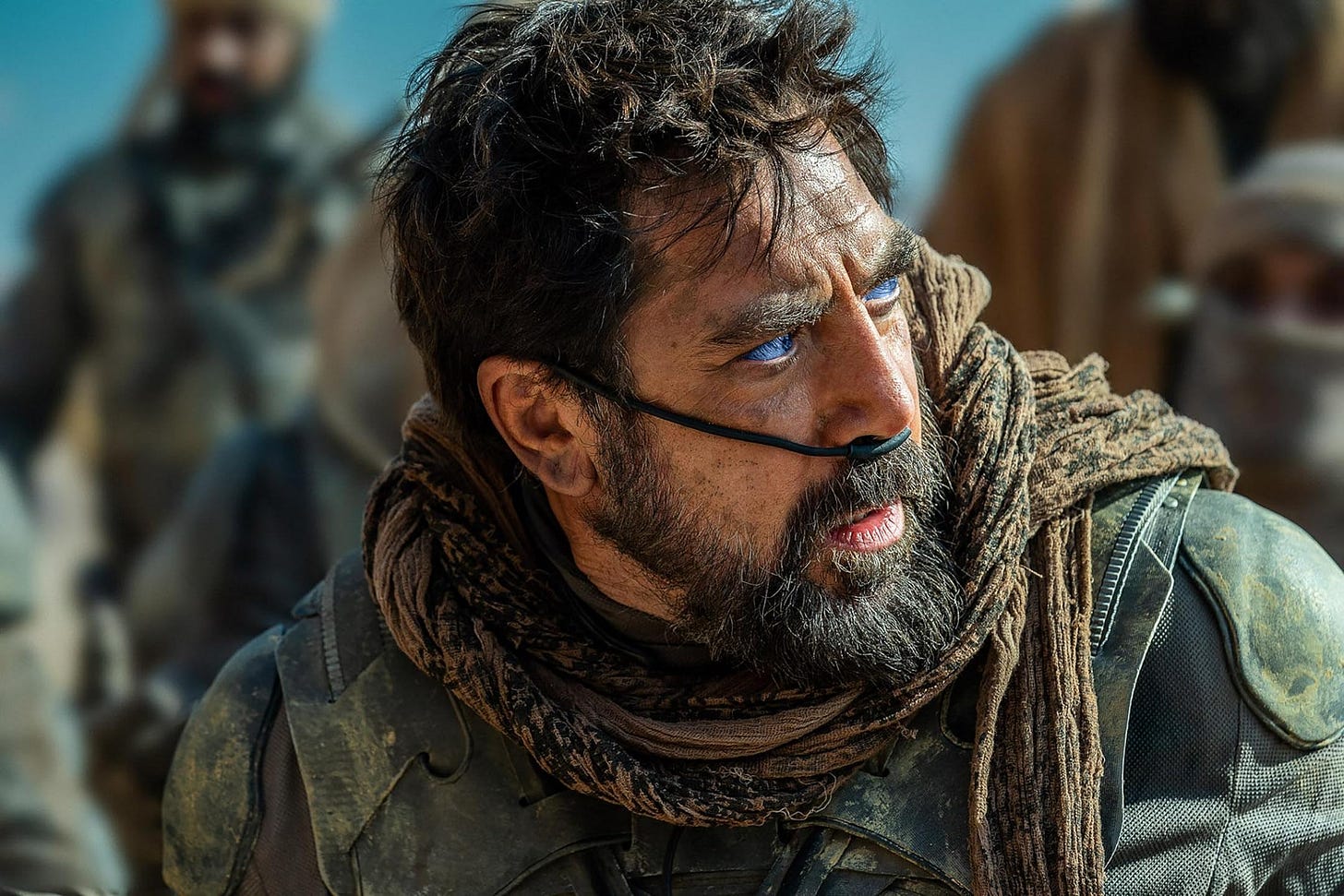‘Dune: Part Two’ Review
Lawrence of Arrakis.
“THE WORLD HAS MADE CHOICES FOR US.”
Chani (Zendaya) says this to Paul “Muad’Dib” Atreides (Timothée Chalamet) as the climactic battle between the Fremen natives of Arrakis led by the remnants of House Atreides and the loathsome Harkonnens approaches. It echoes a line from Gurney Hallack (Josh Brolin) to Paul in the first movie: “You fight when necessity arises, no matter the mood. Now fight!” The point is simple: Plans are all well and good and peace may be preferable to war, but when a band of savages shows up aiming for your elimination, you have no choice but to meet them on their own terms.
To the extent that fate exists, it is the world narrowing our options. To the extent that free will exists, it is the choice we make from those options. This is the central element of Paul’s internal struggle, and one that should be familiar even to those who have trouble getting past the mystic silliness—the space-and-time-bending “spice”; the generations of Bene Gesserit interbreeding that led to the emergence of a chosen one; the “water of life” that allows a fetus to communicate psychically with her mother and with her brother—inherent to Dune. We are, all of us, presented with choices. The path to survival—of a great house, or a great people, or a system of government—is sometimes narrow.
The world makes choices for us and we fight when the necessity arises.
Dune: Part Two picks up more or less right where Dune: Part One left off. After a brief reminder in the form of a diary entry by Princess Irulan (Florence Pugh) that the Atreides clan was killed in the dark desert planet of Arrakis by the Harkonnens, we return to that desert. Paul, along with a handful of Fremen pallbearers, carries a body back to an underground Fremen village, where he and his mother, Jessica (Rebecca Ferguson), seek protection.
The Fremen, on the other hand, seek a messiah. Or at least some of them do. Stilgar (Javier Bardem) has believed from the beginning that Paul is Lisan al-Gaib, The Voice from Another World. Stilgar and the southern fundamentalists believe in a prophecy seeded long ago by the Bene Gesserit, a sect of witches to which Jessica belongs. The Bene Gesserit have for generations served as powers behind thrones, cultivating a genetic line intended to bring about a man with the power to see beyond space and time.
Chani is not a believer of such prophecies. She thinks them to be a lever of control, a tool to ensure compliance. If you keep the colonized waiting for a savior from the stars, they will patiently bow to their colonizers. Adding to the tension is Paul’s own desire to avoid going south; he has seen where this path leads, and the result is bloody. Death counts in the billions as the fundamentalists rally to his side and spread galactic jihad. (Sorry, “holy war.” The word “jihad,” used quite prominently and frequently in the books, has no place here. This is just a group of desert fundamentalists who believe so deeply in their prophet that they plan on spreading his word violently through the galaxy.)
Dune: Part Two is at its best when it uses the epic vistas of the desert to its advantage. From fighters burrowing in the sand and springing up to surprise their victims to warriors standing on great sand dune ridges, a setting sun silhouetting their frames, the desert almost inherently projects scope and scale. Yes, this movie is a bit more monochromatic than the first, but the blue eyes of the Fremen and the sparkling spice out on the sweeping sands give everything a twinkle.
Speaking of monochrome, we briefly sojourn to Giedi Prime, the homeworld of the Harkonnens. While here, director Denis Villeneuve chooses to shoot outdoor scenes—under the black sun of their planet—with an infrared IMAX lens. It gives the whole thing an ethereal, washed-out look. No wonder these alopecia-suffering goons are so comically wicked; they live in a world devoid of color. Austin Butler plays Feyd-Rautha, the heir to the Harkonnen throne, as though he’s channeling Stellan Skarsgård, who plays Vladimir Harkonnen. Just close your eyes during one of Butler’s scenes: he’s doing a spot-on vocal impression of the elder Skarsgård.
The Harkonnens and their sponsor, the Emperor Shaddam (Christopher Walken), are the weakest point of the film. Whereas the first entry neatly interwove political intrigue and epic set pieces, everything political here feels perfunctory, as preordained as Paul’s visions. The partnership of the emperor and the Harkonnens is barely sketched; the emperor himself feels like a shell, impotent and powerless, buffeted by the winds of fate. As such, the final battle feels a bit underwhelming, almost anticlimactic. There’s nothing with the same epic, emotional scope as the moment in Part One when the slaughter of House Atreides begins, bagpipes screaming as ships explode and swords are crossed.
The real struggle in Part Two is Paul’s and Paul’s alone. He must unite the Fremen. He must become their messiah. Yet he fears what will happen to the universe if he takes on that role. He fears that he will lose Chani if he does what needs to be done and marries the emperor’s daughter in a last-ditch effort to stave off intergalactic war. And it’s not just Paul at war with himself here: screenwriter Jon Spaihts, who shares a writing credit with Villeneuve, is clearly concerned with the optics of Chalamet taking control of this desert people; one can practically hear them muttering “white savior” while writing. Paul repeatedly says the leader must come from the Fremen people; the closing shot of the film is on Zendaya rather than Chalamet.
And yet the greatest moment in Dune: Part Two comes when Paul finally makes his choice, going full Braveheart, telling the tribesmen that their traditions are foolish, that he knows best, commanding them to follow his lead as they embark on the first step of their holy war. As much as it pains me to admit,1 this is an “oh wow” moment for Chalamet, the first time I’ve ever seen him onscreen and thought “yeah, he’s definitely got it.”
My favorite performance, though, has to be Javier Bardem’s. As Stilgar he brings both the gravitas of an elder warrior and the sort of infectious joyousness of religious belief that makes you understand both the power of prophecy and why his people would follow Paul. The boy can do no wrong for Stilgar: If he denies he is the messiah, it is because he is humble; if he rejects their traditions, it is because he is wise. Paul’s ascent to prophet only works if we see it in Stilgar’s eyes, and Bardem sells it perfectly.
Dune: Part Two doesn’t end quite as abruptly as its predecessor, which felt distinctly like half a film. But it also doesn’t complete the story either. The end of this film signals the beginning of a galactic war. The oceans may one day return to Arrakis, but that is of less interest than the oceans of blood about to be shed. The holy war to come is what everything—the dynastic and political and familial and religious intrigue—has been building toward. One hopes we get to see it.
See the description of Chalamet in my review of Dune: Part One.





